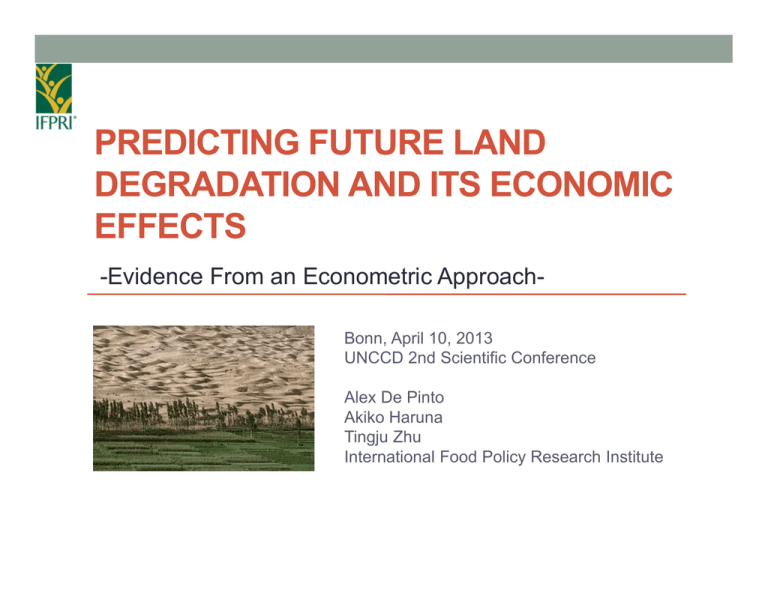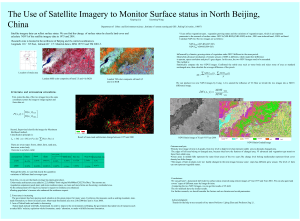PREDICTING FUTURE LAND DEGRADATION AND ITS ECONOMIC EFFECTS -Evidence From an Econometric Approach-
advertisement

PREDICTING FUTURE LAND
DEGRADATION AND ITS ECONOMIC
EFFECTS
-Evidence From an Econometric ApproachBonn, April 10, 2013
UNCCD 2nd Scientific Conference
Alex De Pinto
Akiko Haruna
Tingju Zhu
International Food Policy Research Institute
Purpose of the study
“Land degradation is silent emerging
process that increases the risk for the
livelihood of millions”
“Prevention is less costly than restoration”
Create a tool that allows to “reasonably”
predict land degradation and to prioritize
action.
Establish a link between LD, climate change
and food security.
Major drivers of land degradation
What the literature says:
Physical drivers
Socioeconomic drivers
Climatic factors
Domestic Policy
+
-Rainfalls
+
Institutional capacity
+
-Rainfall intensity
-
Land tenure/property rights
+/-
-Wind
-
Technology
+/-
Slope
-
Information
+
Vegetation cover
+
Population density
-/+
Soil type
Fire
Economy
-
Selected source: Huber et al. 2011; Begue et al. 2011; Zhao et al. 2010; Safriel
and Adeel 2005; Ravi et al. 2010; Le et al. 2012; Sonneveld and Keyzer 2000;
Vogt et al., 2011; Pardini et al 2004; Eswaran et al. 2001; Young, 2001; Mitchell
2004; Kassam et al. 2009; Jansen et al. 2006; K.J. Wessels et al. 2007; Tesfey,
2006; Geist and Lambin 2004; Pender, Place and Ehui, 2006, Hagos and
Holden, 2006; Mulvaney, Khan, and Ellsworth 2009; Nkonya et al. 2004; Boyd
and Slaymaker 2000, Pretty et al. 2011; Benin et al 2007; Bai et al. 2008; Vlek
et al. 2010; Nachtergaele et al. 2010; Moti Jaleta, Menale Kassie, 2012;
Zimmerman et al., 2003; Li and Reuveney, 2006
-Market access
+/-
-Livelihood diversification
+/-
-Poverty
-/+
-Economic growth
+
+ : beneficial for prevention of LD - : drive LD
+ / - : ambiguous
NDVI: Proxy for LD and Land Carrying
Capacity
• Advantage of NDVI
• Global coverage
• Single index with readily available dataset
• Excellent temporal and spatial extensions
• Weakness of NDVI
• Coarse resolution (for non-global analyses)
• Accuracy of observations
• Differentiation from land cover and land use and other human
interventions
• Truly representative of land degradation?
Approach
• Dependent variable: max NDVI (average 2002-2006)
• We use cross-section data
• Exploit spatial rather than temporal variability
• Increases the richness of the data set
• Explanatory variables include major drivers of land
degradation
• Model (OLS, quadratic form):
• ܻ ൌ ࢼ ࢼଵ ࢄ ࢼଶ ࢄଶ ߳
• Where ࢄ is a location specific vector of climatic,
geophysical, and socioeconomic variables and ࢼ a vector
of parameter estimates
Model and data details
• Dataset: global level
• Covariates: Climatic, Geophysical and socioeconomic
variables
• Control on other ecological factors: 6 AEZ-LPG (length of
plant growth) dummies
• Control for irrigations: Irrigated vs. cultivated land ratio
using IFPRI’s Spatial Production Allocation Model (SPAM)
• Control for potential spatial correlation: regular sampling
method (3x3 grids)
Variables for model estimation
Variable
Resolution
Period
Max. NDVI
0.083o x
0.083o
2002–2006
Avg. Precipitation
0.54o x 0.54o
2002–2006
Rainfall intensity (# of
events 1 S.D. above mean)
0.54o x 0.54o
2002–2006
Avg. Temperature
0.54o x 0.54o
2002–2006
Slope
Soil Organic Carbon
Population density
Access to market
0.008o x
0.008o
0.5o x 0.5o
0.5o x 0.5o
0.008o x
0.008o
Data source
GIMMS-AVHRR
dataset (Global Land
Cover Facility)
Climate Research Unit
(CRU), University of
East Anglia
Climate Research Unit
(CRU), University of
East Anglia
Climate Research Unit
(CRU), University of
East Anglia
GMTED2010, USGS
2000
2000
Avg. GDP growth rate
Country level
2002-2006
Avg. input usage
Country level
2002-2006
Avg. Rules of Law
Country level
2002–2006
Infant Mortality Rate
Regional level
2000
Hiederer et al (2012)
CIESIN
Uchida and Nelson
(2009)
UNSTAT constant
2005 prices
The World
Development
Indicators
Worldwide
Governance Indicators
CIESIN
OLS regression coefficients
Dependent variable: max NDVI – Range [-1, 1]
Expl. VARIABLES
Precipitation
Above mean and 1 S.D. of
precipitation
Temperature
Slope
Soil Organic Carbon
Population density
Access to market
Infant Mortality Rate
GDP growth rate
Rule of law
Input usage
Irrigated area
AEZ dummies
Coefficient
0.0002**
-0.008**
-0.005**
-0.007**
0.001**
-4.49e-05**
-2.63e-05**
-0.001**
0.009**
-0.011**
-0.0002**
-0.045**
0.217**; 0.262**; 0.295**; 0.291**; 0.307**
Observations
211,332
R-squared
0.69
** p<0.01, * p<0.05, + p<0.1
OLS regression coefficients
Dependent var: NDVI maximum
VARIABLES
Precipitation
Above mean and 1
S.D. of precipitation
Temperature
Slope
Soil Organic Carbon
Population density
Access to market
Infant Mortality Rate
GDP growth rate
Rule of law
Input usage
Irrigated area
Observations
R-squared
Coefficient
0.0002**
-0.008**
-0.005**
-0.007**
0.001**
-4.49e-05**
-2.63e-05**
-0.001**
0.009**
-0.011**
-0.0002**
-0.045**
211,332
0.689
VARIABLES
Precipitation2
Above mean and 1
S.D of precipitation2
Temperature2
Slope2
SOC2
Pop density2
Access2
IMR2
GDP growth rate2
Rule of law2
Input usage2
Irrigated area2
Coefficient
-3.54e-08**
-0.0003**
3.98e-05**
0.0001**
-2.61e-06**
1.30e-09**
5.22e-10**
6.37e-06**
-0.0006**
0.010**
6.69e-08**
0.066**
AEZ dummies
Constant
0.394**
Future scenarios
• We use our ࢼ estimates to project NDVI into 2050
(Logic: if predicted NDVI ↓ land degradation ↑)
• Year 2050; IPCC SRES A1B scenario; 2 GCMs (CSIRO-Mk3.0 and
MIROC 3.2)
Variable
Resolution
Period
Data source
Precipitation
0.54o x 0.54o
2050
Jones et al. (2009), Downscaled
IPCC-AR4 GCMs
Rainfall intensity (1 S.D. above mean
precipitation)
0.54o x 0.54o
2050
Jones et al. (2009), Downscaled
IPCC-AR4 GCMs
Temperature
0.54o x 0.54o
2050
Jones et al. (2009), Downscaled
IPCC-AR4 GCMs
Population density
0.5o x 0.5o
2050
UN World Population Prospects
GDP growth rate
Country level
2050
IMPACT pessimistic scenario
Input usage (fertilizers)
Country level
2050
(Wood et al, 2004)
Mortality rate
Regional level
2050
Derived from IMPACT
malnutrition estimate
Slope, SOC, Access to market, Rule of
law
Constant from the
2000’s
Areas with declines in NDVI
2000 – 2050 Socioeconomic variables only
Climatic variables have an impact
MIROC pessimistic scenario
Climatic variables have an impact
CSIRO pessimistic scenario
Implication for food security
• Estimation of global calorie production:
• 16 major food crops (wheat, rice, maize, barley, millet, sorghum,
potato, sweet potato, cassava, banana and plantain, soybean,
other beans, other pulse, sugar cane, sugar beet, ground nuts)
• Yield and harvest area: 0.083o x 0.083o spatial dataset (SPAM)
• Calorie per unit of product (USDA, FAO)
• Calorie production per pixel = ∑ {Calorie per unit of product X yield
per product per area X harvest area per product per pixel }
• Large NDVI decline with major food production area
• Areas with NDVI change below mean of all negative NDVI changes
• Areas with calorie production above mean of all calorie productions
Food security implication: MIROC
Identified areas with below mean of negative NDVI changes and areas
with above mean of calorie production
MIROC pessimistic scenario: 116 million ha of above-average
production cropland affected (current output: 65 billion USD per year)
Food security implication: CSIRO
Identified areas with below mean of negative NDVI changes and areas
with above mean of calorie production
CSIRO pessimistic scenario: 105 million ha of above-average
production cropland affected (current output: 54 billion USD per year)
Food security implication:
Dark Red: Areas with below mean of negative NDVI changes and areas with
above mean of calorie production
MIROC pessimistic scenario: 116 million ha of above-average
production cropland affected (current output: 65 billion USD per year)
Food security implication:
Dark Red: Areas with below mean of negative NDVI changes and areas with
above mean of calorie production
CSIRO pessimistic scenario: 105 million ha of above-average
production cropland affected (current output: 54 billion USD per year)
Food security implication:
Dark Red: Areas with negative changes in NDVI greater than 10% and areas
with above mean of calorie production
CSIRO pessimistic scenario: 13 million ha of above-average production
cropland affected (current output: 11 billion USD per year)
Food security implication:
Dark Red: Areas with negative changes in NDVI greater than 10% and areas
with above mean of calorie production
MIROC pessimistic scenario: 15 million ha of above-average production
cropland affected (current output: 13 billion USD per year)
Other possible important implications:
Biodiversity Hotspots: at least 1,500 species of vascular plants as
endemics, and it has to have lost at least 70 percent of its original habitat
Source: Conservation International
Other possible important implications:
Predicted LD hotspots (MIROC) and biodiversity hotspots
Conclusions
• One step towards a predictive tool for LD and the
inclusion of climate change effects
• Substantial food production areas potentially
affected by LD
• Climate change appears to exacerbate LD in
certain areas
• More work on linking NDVI to reality on the
ground (recent work of Bao, Vleck, and others)
• A call for a close collaboration among scientists
from different disciplines


